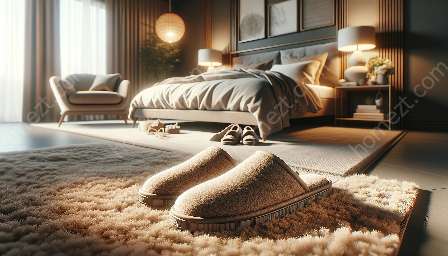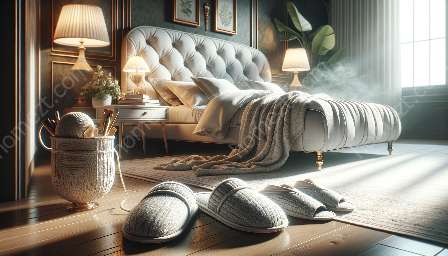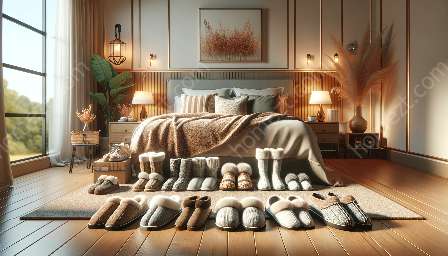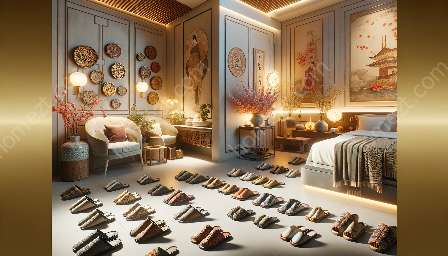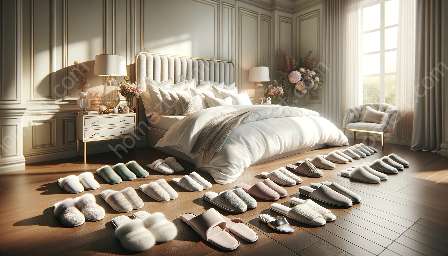Slippers have been an integral part of human culture for centuries, serving both practical and symbolic purposes. From the ancient civilizations to modern-day fashion, the history of slippers offers a fascinating glimpse into the evolution of footwear and its connection to the bed & bath lifestyle.
Ancient Origins
The history of slippers dates back to ancient civilizations such as Egypt, where they were worn as a symbol of wealth and status. The Pharaohs and nobility adorned themselves with ornate and elaborately decorated slippers that showcased their elevated social standing. These early slippers were often made from luxurious materials such as leather, silk, and precious metals, reflecting the opulence of the era.
In Asia, the tradition of wearing slippers can be traced back to ancient China and Japan, where they were designed to be worn indoors as a sign of respect for cleanliness and etiquette. The distinct styles of Chinese and Japanese slippers, known for their intricate embroidery and delicate craftsmanship, have endured through the centuries, becoming iconic representations of cultural heritage and refinement.
Medieval Europe and Renaissance
During the Middle Ages, slippers evolved in Europe, catering to the aristocracy and clergy. Luxurious fabrics, such as velvet and brocade, were used to create lavish slippers, often adorned with jewels and intricate embellishments, reflecting the refined taste and social status of the wearers. The Renaissance period witnessed a resurgence of interest in classical art and literature, leading to the revival of ancient Roman and Greek footwear styles, which influenced the design of slippers among the elite.
Colonial Influence and Global Expansion
With the exploration and colonization of new lands, the history of slippers experienced a global exchange of influences. In the Americas, indigenous cultures had their own traditional footwear, such as moccasins and sandals, which eventually merged with European designs to create unique slipper styles. Similarly, in Africa and the Middle East, traditional slippers, including the iconic Moroccan babouche and Turkish yemeni, showcased rich cultural diversity and craftsmanship.
Industrial Revolution and Mass Production
The advent of the Industrial Revolution marked a significant shift in the production of slippers. The mechanization of manufacturing processes enabled mass production, making slippers more accessible to a broader segment of the population. This democratization of footwear led to the proliferation of comfortable and practical slippers for everyday use, contributing to their widespread popularity in the bed & bath lifestyle.
Modern Era and Fashion
In the 20th century, slippers underwent a transformation from traditional and utilitarian designs to fashionable and stylish options. Influential designers and brands embraced slippers as a versatile fashion accessory, incorporating new materials, textures, and silhouettes to cater to evolving consumer preferences. Today, slippers are not only valued for their comfort and functionality but also for their expression of individual style and personal identity.
Bed & Bath Lifestyle
The history of slippers is inherently intertwined with the bed & bath lifestyle, as they are essential for providing comfort and warmth at home. From cozy fleece-lined slippers for chilly winter nights to lightweight and breathable options for spa-like relaxation, slippers have become synonymous with leisure, self-care, and relaxation in the domestic environment. They offer a seamless transition from the bed to the bath, enhancing the overall experience of comfort and well-being.
Cultural Significance
Throughout history, slippers have held cultural significance, symbolizing various aspects of identity, tradition, and social norms. Whether representing royalty and opulence in ancient civilizations or embodying comfort and casual elegance in contemporary society, slippers continue to serve as a reflection of cultural values and lifestyle choices.
In conclusion, the history of slippers transcends time and geography, offering a captivating narrative of human creativity, craftsmanship, and societal evolution. From their origins in ancient rituals to their role in modern-day relaxation, slippers remain an enduring symbol of comfort and style, seamlessly integrating with the bed & bath lifestyle.

